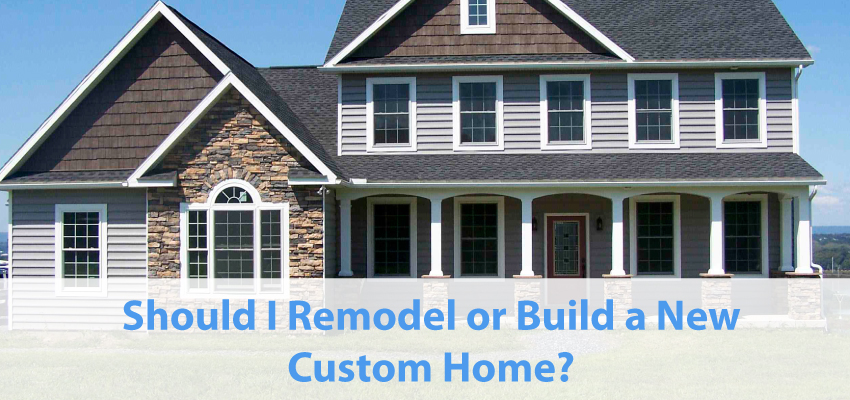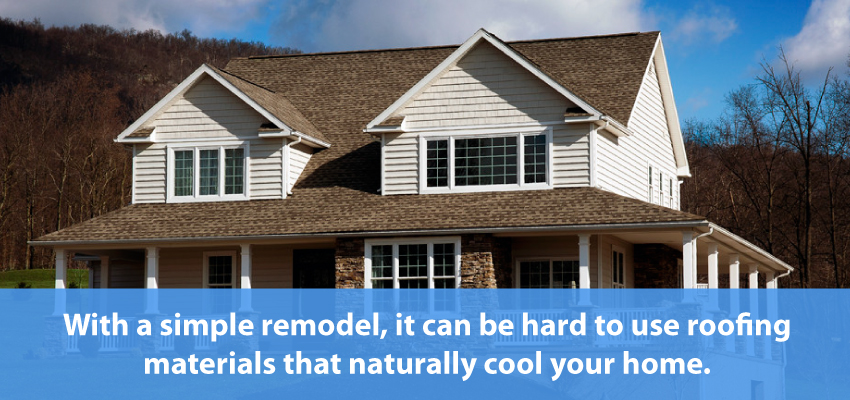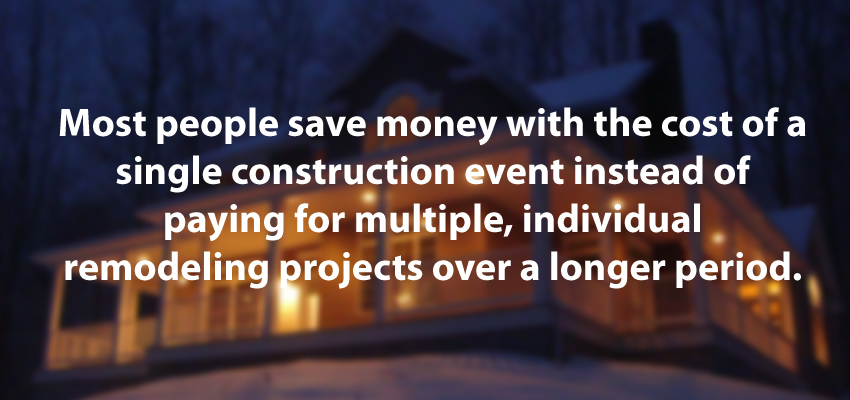Should I Remodel or Build a New Custom Home?

Should I Remodel or Build a New Custom Home?
Cars, furniture and clothes are easily updated for what’s modern, but what happens when you realize your home is out of date and out of style? Many homeowners find themselves faced with this reality and one simple question: should I remodel my house or buy a new one?
There’s no easy answer to the remodeling vs building new debate, because the decision depends on what you want out of your home and how long you plan to live in the update. While it’s tempting to start by asking if it is cheaper to remodel or build new, focusing purely on initial cost may end up hurting your long-term value and take options you love off the table.
This guide aims to help you understand the benefits and dangers of remodeling a house vs building new by addressing some common questions and factors. We can’t answer the question for you, but we will make your decision a whole lot easier.
Remodeling Vs Building New: What Do You Want Most?

When deciding on building new or remodeling, you first need to know what’s most important to you and what type of home you want. Ask yourself what you dislike about your existing home and why you’re considering a change.
A family that’s growing and a family where the kids have left the nest for good will likely need two very different homes. It may be more important to add on new bedrooms or to turn small, unused rooms into a larger space for entertaining. Sometimes people want to achieve a certain goal, like having room for a hot tub or adding large bay windows to take advantage of a great view.
Knowing what you want can give you a good point to determine what you might need, such as a completely new construction, and it can help you prioritize your timeframe, budget and more.
Remodeling a House Vs Building New: Interest Rates and Equity
The starry-eyed among us often focus on the amazing new possibilities that a new or remodeled home could provide. We imagine parties in the expanded dining room or plan what color to paint the new nursery. The ethereal details help us frame our desires, but there’s also a strong need for firm financial footing in the real world.
Many mortgages include clauses that address whether or not you can tear down your home, freeing up land for a rebuild. Sometimes stipulations are placed on how soon the rebuilding process must begin. Sometimes lenders ask to be included in the planning process. And sometimes your mortgage may forbid demolishing your home.
The main reason behind this is that you’re destroying the security the bank or lender has for your loan. Demolishing your home can also negatively affect your equity in a significant way. You can quickly dip into negative equity, which may prevent you from using a home equity loan product. When your home is demolished and a new one is built in its place, you’re responsible for cost of construction and you must eat some of the lost value when you lose equity in the building that is gone.
To address this, you may need a new mortgage or a line of credit that operates along the same lines of a mortgage. You’ll need some collateral, which is typically the new or renovated home, and often you’ll need to bring some of your own cash to the table.
Take your time with these financial decisions and look at your options available, including FHA and traditional loans with 15-year, 30-year, fixed and variable rates. To start the new home process, you should obtain a prequalification or preapproval from your chosen lender for a mortgage.
When considering these financial products, you should shop around to find the best interest rates, repayment terms and fee schedules. Some lenders may offer you advantages such as no origination fees or early repayment penalties, which can make a big difference in the amount you’ll pay throughout the life of the loan.

It’s often easier to get a loan if you know how much value your new build or remodel will create. To increase your home’s value, you should consider fiberglass insulation, door replacements and minor kitchen remodels.
Always discuss your financing options with a professional. The Internet doesn’t always provide correct information or the latest loan APRs, so you may find a better deal by working with someone directly.
Remodeling Vs Building New: Going Green

How green you want to be can also help you make a decision about remodeling a house vs building a new home.
Remodeling your home provides you with access to some innovations in the eco-friendly space, such as windows, siding and appliances. However, you won’t be able to make many structural changes, such as replacing whole-home ventilation with a more efficient HVAC system.
Building a new home gives you the opportunity to make greener choices. You can ensure every wall has high-efficiency insulation, and that water-saving fixtures are used. You can downsize to reduce your overall impact.
With a simple remodel, it can be hard to:
- Free up enough roof and outside space to make a significant switch to solar power
- Use roofing materials that naturally cool your home, such as a “living roof” that allows plants to grow, catches rainwater, filters the water and provides insulation for your home
- Take advantage of other natural alternative power sources, such as geothermal power for your HVAC
- Incorporate systems that collect and filter rainwater for home use
- Ensure your home is tightly sealed; remodeling can create new concerns or exacerbate existing leaks in areas that were not remodeled
It may seem like it is cheaper to remodel instead of build new, but some eco-friendly additions and renovations will deliver long-term savings on your energy bills. You’ll also reduce your environmental impact, put a higher reliance on recycled materials and have a more sustainable lifestyle, all of which have a significant non-monetary value.
Remodel Vs New Construction: What’s Your Time Frame?
Homeowners deciding on remodel vs new construction should determine how long they can afford to be away from their home while the process happens. Remodeling and building both require time and disruption of your everyday life. Let’s examine possible timeframes for remodels and new construction:
Home Remodel

Depending on your situation, you might be able to use much of your home during the remodeling process. If you plan appropriately, you can limit the remodel to a few rooms and perform tasks in a certain order. Remodeling can take one week to nearly 10 weeks based on the project. The longest projects tend to be large room changes, such as converting a bedroom to an attic. Thankfully, large room changes tend to create minimal disruption.
A bathroom renovation or refinishing hardwood floors are typically the most disruptive, but they take about two weeks. During this type of remodel, you have to avoid large areas of your home. You’ll experience interruptions like shutting off the water, and you’ll need to be completely out of the house while fumes from some floor finishing solutions dissipate.
It’s typically easy to manage living in your home during an exterior remodel. For siding and roof replacements, you probably won’t need to move out and the biggest distraction is noise. The remodel will likely occur during regular work hours.
The unfortunate side of things is that your home may require multiple projects in order to complete a full remodel and many of these cannot happen at the same time. Sometimes long strings of renovations and remodels take more time than a new home construction would.
New Construction

Building a new home usually takes longer, and you’ll have to find another place to stay while the construction happens. A completely new home takes about six months from demolition to the finishing touches. There are options you can choose to save time if you choose a modular build, but going the other direction with a completely custom-designed and custom-built home can greatly extend the timeframe.
With our long history of new home construction, we’ve identified a few key factors that impact the length of time it will take to complete your new home:
- The size of the home you want
- What type of home you want, including overall design and floors
- Custom design options and overall complexity
- Design changes — most people want to maximize good views and sunlight
- Builders you choose and their team of subcontractors
- Your city and county building and licensing departments
- The weather over the course of your project
- Unexpected weather events, which can delay construction or make building materials in your area scarce
There are many working pieces for any new home construction, and they’re significantly more involved than most home remodels. That means if time is short, a remodel will win out in the consideration of: should I remodel my house or buy a new one?
The Home Construction Process
A home construction comes with a lot to consider, and it can be hard to put into context. A general outline of the construction process may help you better understand the complexity of the process. Here’s what you can expect:
- Week 1. The first week is an exciting time — it’s when you’ll break ground on your new home. The old home is demolished and removed. Bulldozers and compactors work your land for excavation and leveling. If you’re having a basement created, it’s properly dug out while the main home footers are built.
- Week 2. Your foundation is laid this week. This covers the slab foundation for your home, as well as any basement foundations, crawlspace foundations and knee walls. Building inspectors must be scheduled to come onsite and make sure your foundation is secure.
- Week 3 to Week 5. The skeleton of your house is created and the framing work is completed between weeks 3 and 5. Rough outlines of doors, windows and interior walls emerge. Houses in this stage are wrapped in an exterior sheathing to protect them from the weather during construction. Your roof is put into place and completed, and inspections of the roof and overall building take place. The structural integrity is tested, and afterwards the exterior walls are completed.
- Week 6. Plumbing, ventilation and wiring dominate week six, including setups for all of your utilities and any special requests. If you plan on installing a wired security system, it’s typically installed around week 6. Some new homes with advanced setups for Internet connectivity will also have their work performed this week. Professionals and specialists dominate week 6, so you may experience some delays in the process if there is an issue with a subcontractor. Building inspectors will also make multiple visits during the week to ensure that everything is up to code — this can cause delays in busy construction seasons. By this point, most standard remodeling work is finished.
- Week 7. Mechanical workings and wirings are finished. Plumbing is checked and verified. Afterwards, your home’s insulation is installed. You’ll see a great financial savings on your heating and cooling bills compared to a remodel, because you can properly insulate your entire home, attic and basement during the home construction process.
- Week 8. Drywall is installed after the insulation is finalized. The interior of your home will start to like what you imagined. Drywall is installed, puttied and sanded for a secure setting and a smooth finish. Primer paint is also applied. By this point, most home remodels are complete, even complex jobs such as converting an attic or basement into a new bedroom.
- Week 9. Baseboards, casings, flooring and trim are installed during week nine of a typical home construction. Your doorframes and windows are finished. Molding on the walls and ceilings are readied, and your beautiful floors are finalized. The only exception is carpeting and soft floors, such as bamboo, which are installed later to prevent early wear. Interior settings, like tile in your kitchen and bathrooms, are completed this week. New options give you better protection against mold and mildew. Complex designs have become standard, so you can see beautiful backsplashes and more installed this week. Cabinets and cupboards are installed, but the doors are installed after to prevent any scratching.
- Week 10. Many homeowners like to take a peek during week 10, because this is when your interior walls receive their final color. Work begins on your yard and exterior. Landscaping, such as trees and shrubbery, is installed along with fountains, hot tubs and other pleasantries. Lawn, gravel, mulch and stone are added if planned. Inspections happen during this week, as well. You confirm that the colors are correct and the overall look is right. You can make adjustments before work is complete and ask questions about anything.
- Week 11 and 12. It’s time for the finishing touches. All of your fixtures and appliances are installed and tested, from the washer to every light switch and cover. At this point, your HVAC and water system are tested. Any system adjustments are made to ensure your new home is move-in ready.
- Week 13. The construction process is nearly finished, and you’re almost ready to move in. Final inspections are performed. Local inspectors from your city and county will inspection everything to ensure safety. You also come in and perform your own final inspection. You make sure everything looks perfect. Once you approve, you receive the keys and schedule an appointment to review the HVAC and security systems.
An explanation of the process may not be at the top of your mind right now, but it’s important to consider how long the process will take when deciding to build new or remodel your current home.
Build New or Remodel: How Long You’ll Stay
Determining if it is cheaper to remodel or build new may come down to how long you want to live in your home after the project is completed.
Remodels often provide the biggest short-term gain because they make improvements usually against existing equity, with a focus on immediate returns. New construction can be more difficult to finance and you have a bigger expense to pay off, so an increase in your home’s worth takes longer to become advantageous.
In the simplest of terms, remodels are often the better choice for homeowners who will not stay in the home for more than seven years but who want to enjoy the time they have left in the home. Since gains are largest in the short term, remodeling often gives you the biggest bang for your buck if you’re selling soon.
When you want to build new, which is not cheaper than your remodel option, you’ll see a better lifetime value if you’re not planning to move. You get more enjoyment out of what you pay for and don’t have to focus on immediately recouping your money and equity. Most people save money with the cost of a single construction event instead of paying for multiple, individual remodeling projects over a longer period.
A new home will often have a higher value. If the housing market in your area takes off, you can capitalize and likely make a good profit. When selling, you can also look at adjustable-rate mortgage refinancing that will give you bigger bang, essentially by reducing your mortgage payments while your home is on the market.
Pre-Priced Planning
One big advantage of modern construction is that you can take advantage of established pricing models. With modular designs of homes and pre-fab construction options, it’s now very easy to predict the cost of construction.
To help you understand this development, SDL Custom Homes offers a full set of pre-priced plans and galleries. You’ll understand of all the options, know how to estimate your costs and experience innovative ways to save. Check out this amazing new option to see where you might save over a remodel.
Making Your Choice With an Estimate
Now it’s time to solve the remodel vs new construction debate for your home. Define what you’re looking for and what’s most important to your family, wallet and your time. It’s best start by obtaining your first bid, and you can do so with SDL Custom Homes right away.
Simply fill out our free estimate form and we’ll walk you through the entire home development process with pre-priced plans, galleries to choose from and much more.






